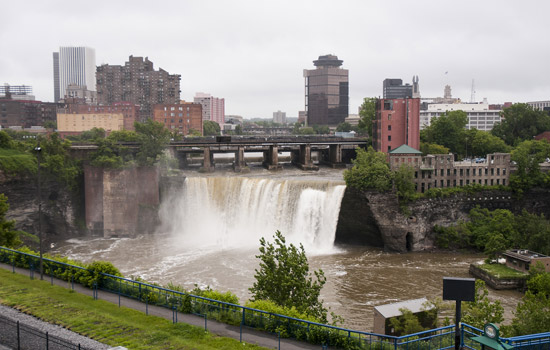RIT’s next Big Shot returns to Rochester
Organizers looking to secure vintage train for icy scene on Feb. 9, 2014
RIT Big Shot Team
RIT’s 29th Big Shot photo project is scheduled for High Falls in Rochester on Feb. 9, 2014.
RIT’s Big Shot is coming home to Rochester.
After capturing a spectacular nighttime photograph of Cowboys Stadium earlier this year, the Big Shot team is preparing to point its lenses at one of Rochester’s natural and iconic spectacles: High Falls, one of three waterfalls on the Genesee River that flow through the city.
For the first time since a shot of the Liberty Pole in December 2000, Big Shot No. 29 will be a winter picture—sunset on Sunday, Feb. 9, 2014. Organizers say they look forward to capturing a frosty scene.
“The winter time appealed to all three of us for this shot. We’re hoping for plenty of snow and ice,” says Michael Peres, referring to fellow team members Dawn Tower DuBois and Willie Osterman. “We also picked a Sunday night because the rail business is slower, the number of trains will be fewer and the city traffic will be quieter.”
While meetings with city of Rochester officials have already begun, planning is in the fledgling stages. The team’s biggest wish is to secure a vintage train—frozen in time—on the track overlooking the falls, making the photo more nostalgic.
“We’re having some unique conversations with people, including railroad museums and the railroad company,” says Peres. “We’re also talking with the power company about possibly controlling the flow of water over the falls. As with every Big Shot, this is a community art project.”
The Big Shot relies on the participation of hundreds of volunteers to provide the primary light source for the image while RIT photographers shoot an extended exposure. It’s a signature event for RIT and is led by the School of Photographic Arts and Sciences, which is nationally recognized for its degree programs.
The Big Shot is often described as “painting with light” because volunteers are asked to “paint” or shine their light source onto a particular area of the landmark while the photograph is taken. The light sources are either handheld flashlights or camera flash units.
The High Falls area was the site of much of Rochester’s early industrial development, when industry was powered by falling water. Browns Race diverts water from above the falls and was used to feed various flour mills and industries. Today the water is used to produce hydroelectric power.
The falls may be viewed from the Pont De Rennes Bridge, a pedestrian bridge that spans the Genesee River a few hundred feet from the base of the falls.
Since RIT started its Big Shot project in 1987, the event has hopscotched to several national landmarks and twice crossed the Atlantic Ocean. Through their viewfinders, Big Shot photographers have captured such landmarks as The Alamo in San Antonio, Texas; the U.S.S. Intrepid in New York City; Pile Gate in Dubrovnik, Croatia; the Royal Palace in Stockholm, Sweden; and the Smithsonian National Museum of the American Indian in Washington, D.C.













